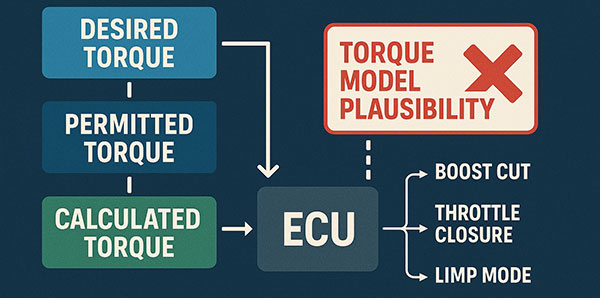Torque monitoring disable is a specialised ECU calibration designed for platforms that implement advanced torque model checks. These control units compare desired torque, permitted torque and calculated torque (derived from boost, airflow, ignition and lambda). When these values diverge from factory plausibility thresholds, the ECU intervenes by cutting boost, closing the throttle or entering limp mode.
Torque Monitoring Disable — Torque Model / Plausibility Off

In real-world tuning, this calibration is used when the engine produces more torque than the original model expects, even if hardware and sensors are functioning correctly. The result is repeated interventions that disturb drivability on otherwise well-built setups.
For background on torque in powertrain engineering, you may refer to the technical definition of torque.
This torque plausibility-off strategy disables only the specific checks responsible for false torque-cut events. Knock control, temperature protection, overboost limitation and oil-pressure safeguards remain fully active so the engine continues to operate within a controlled safety envelope.
How torque plausibility disabling works
Modern ECUs follow a multi-stage torque path: driver wish → requested torque → permitted torque → delivered torque. Internally, they compare expected values with inverse torque models. When the deviation exceeds factory thresholds, the ECU reacts as if a mechanical fault were present and applies torque reduction.
This monitoring-off approach disables those specific plausibility monitors while preserving the torque structure and arbitration logic. Each solution is bench-validated and dyno-tested to ensure predictable drivability, smooth torque delivery and compatibility with traction, gearbox and ESP systems.
When this service is recommended
- Stage 1/2/3 builds where delivered torque exceeds factory modelling.
- Vehicles with TCU arbitration (DSG, ZF8HP, Aisin) where ECU and TCU requests conflict.
- Hardware upgrades (turbo, injectors, cams) that invalidate the stock inverse torque model.
- Recurring plausibility DTCs such as P061A (“Internal Control Module Torque Performance”).
Benefits and technical notes
- Eliminates unintended torque interventions and limp-mode behaviour.
- Allows safe calibration of higher torque targets without plausibility faults.
- Preserves all main ECU protections (knock, boost, temperature, oil pressure).
- Ideal for tuned builds, engine swaps and custom performance projects.
- Recommended for professional tuners familiar with torque model logic.
Technical background for professional tuners
On many modern platforms, torque validation is integrated with air-mass modelling, VTG control, turbo flow estimation, knock-based corrections and gearbox arbitration. Even with correct calibration, components such as hybrid turbos, high-flow intakes, ethanol blends or increased low-RPM boost can push the inverse torque model outside its intended range. In these cases, the ECU may flag an internal mismatch and reduce torque randomly. Neutralising only the problematic routines preserves model consistency while preventing false torque cuts.
Service CSV not found: Torque Monitoring OffRelated service: Torque Limiter Removal
Many ECUs and TCUs enforce internal torque ceilings that restrict performance even with proper tuning. Combined with this plausibility-off strategy, the Torque Limiter Removal service prevents ECU and gearbox from artificially capping torque delivery.
Torque Limiter Removal — Supported ECU
| Brand | ECU | Instructions |
|---|---|---|
| BMW | ||
| BMW | BOSCH ZF8HP45 | / |
| BMW | BOSCH ZF8HP50 | / |
| Jaguar | ||
| Jaguar | BOSCH ZF8HP75 | / |
| Jeep | ||
| Jeep | BOSCH ZF8HP75 | / |
| Land Rover | ||
| Land Rover | BOSCH ZF8HP70 | / |
| Land Rover | BOSCH ZF8HP75 | / |
| Mercedes | ||
| Mercedes | GETRAG VGS2-FDCT | / |
| Mercedes | GETRAG VGS4 | / |
| Ram Trucks | ||
| Ram Trucks | BOSCH ZF8HP75 | / |
| Renault | ||
| Renault | GETRAG DC4 | / |
| Vag | ||
| Vag | TEMIC DQ200G2 | / |
| Vag | TEMIC DQ200G2PQ | / |
| Vag | TEMIC DQ200MQB | / |
| Vag | TEMIC DQ250C | / |
| Vag | TEMIC DQ250F | / |
| Vag | TEMIC DQ250MQB | / |
| Vag | TEMIC DQ380 | / |
| Vag | TEMIC DQ381 | / |
| Vag | TEMIC DQ400E | / |
| Vag | TEMIC DQ500 | / |
| Vag | TEMIC DQ500MQB | / |
Usage and compliance
This modification is intended for non-road, track or motorsport applications unless local regulations explicitly permit changing torque monitoring logic. Always verify compliance before using modified ECU software on public roads.
To check ECU coverage and related strategies, visit the ECU Service Coverage page. If your software code is not listed, upload your ORI via Tune Your File.
